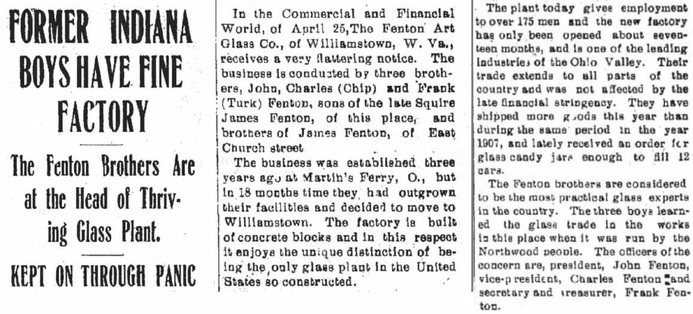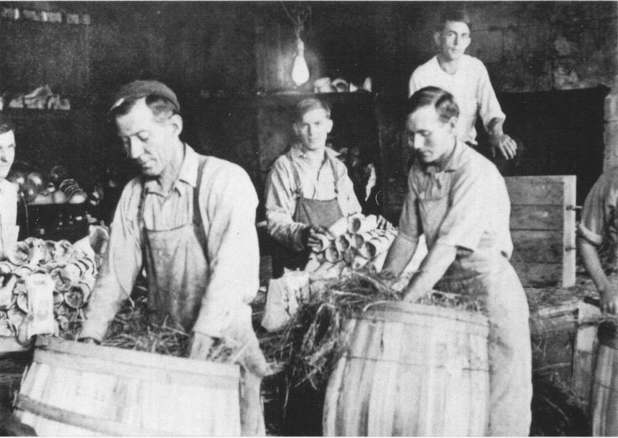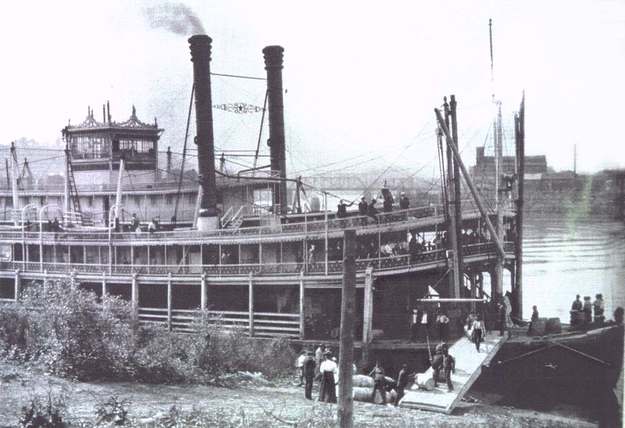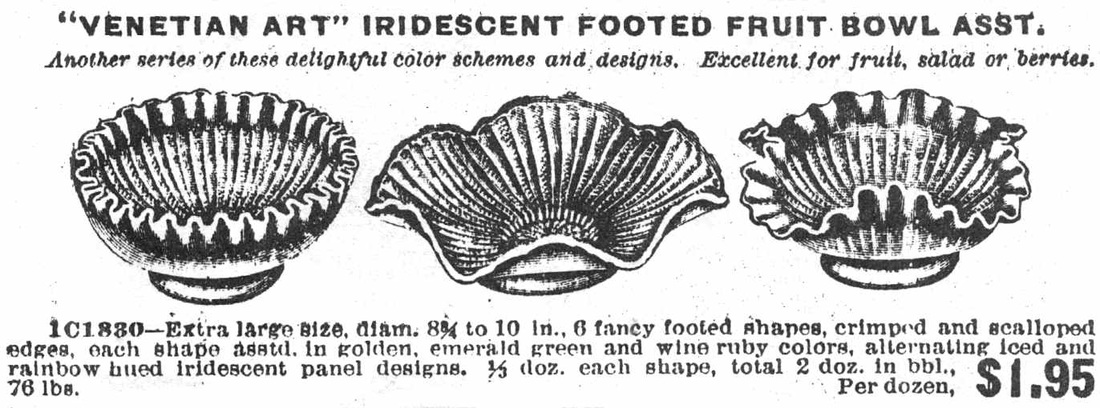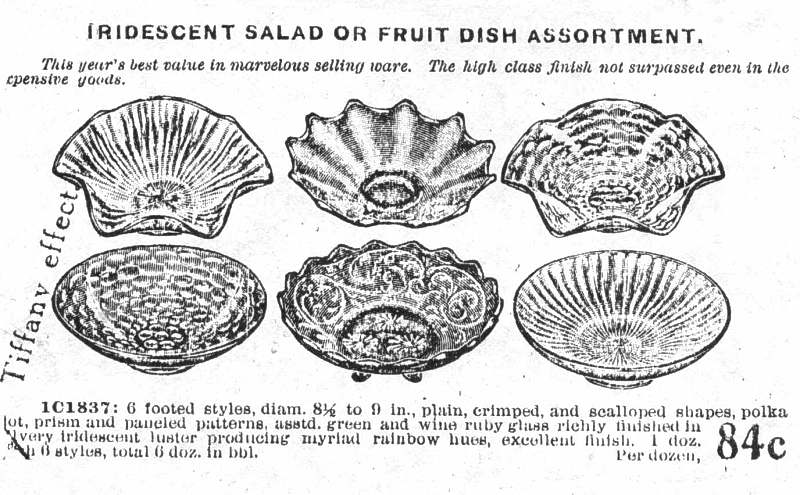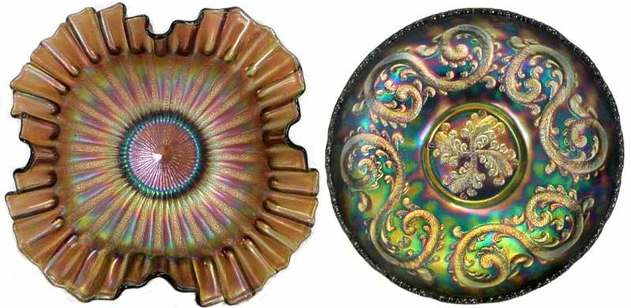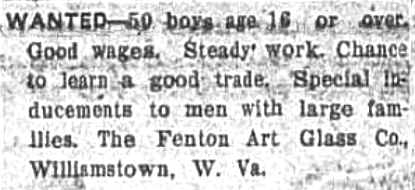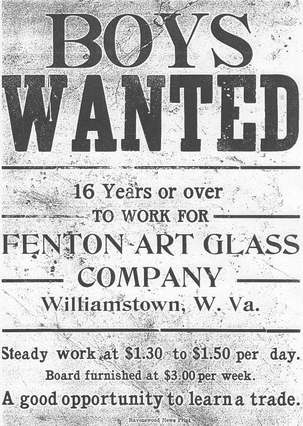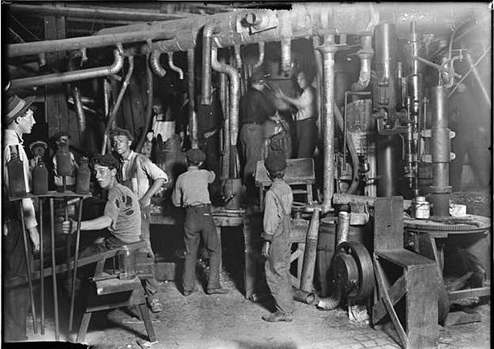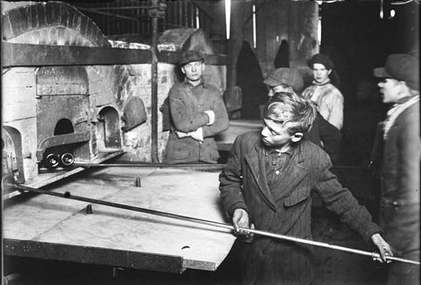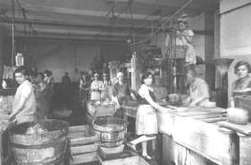Fenton in the Press
Indiana Gazette 1908
The newspaper article that first caught our eye was this one: in bold letters we read FORMER INDIANA BOYS HAVE FINE FACTORY – The Fenton Brothers are at the Head of Thriving Glass Plant.
The article noted that “the business is conducted by three brothers John, Charles (Chip) and Frank (Turk) Fenton” and it went on to explain that “the factory is built of concrete blocks and in this respect it enjoys the unique distinction of being the only glass plant in the United States so constructed.”
The newspaper article that first caught our eye was this one: in bold letters we read FORMER INDIANA BOYS HAVE FINE FACTORY – The Fenton Brothers are at the Head of Thriving Glass Plant.
The article noted that “the business is conducted by three brothers John, Charles (Chip) and Frank (Turk) Fenton” and it went on to explain that “the factory is built of concrete blocks and in this respect it enjoys the unique distinction of being the only glass plant in the United States so constructed.”
|
Note the words at the foot of the main heading: KEPT ON THROUGH PANIC. The “Panic” referred to in the statement was the “Panic of 1907”- a short-lived, financial crisis known as the 1907 Bankers’ Panic or (intriguingly) the Knickerbocker Crisis, sparked by the collapse of the Knickerbocker Trust Company. The article is a fascinating piece of archive commentary on Fenton Art Glass, and the brothers who built the business. As an interesting aside, we had not heard of Frank Leslie Fenton being referred to as “Turk” before, and we wonder how he acquired that intriguing nickname. |
Boats and Barrels, 1907-1908
Above: Workers at the Fenton Art Glass factory circa 1907-1908, packing glassware into straw-filled barrels. They must have been very proficient at filling them as they managed to pack six full water sets or four full punch sets into just one barrel. Smaller items fitted better! There were forty eight regular sized comports (or, if the customer preferred, seventy two standard sized vases) packed inside just one barrel. However, the prize for the fullest packed barrels surely went to the “assortments” which comprised ninety mixed items including bowls, comports, vases and bonbons – all carefully packed into just one wooden barrel. Courtesy Fenton Glass Museum and the late Frank M. Fenton.
Below: Barrels of glass being loaded onto an Ohio riverboat in 1907. Courtesy Fenton Glass Museum and the late Frank M. Fenton.
Below: Barrels of glass being loaded onto an Ohio riverboat in 1907. Courtesy Fenton Glass Museum and the late Frank M. Fenton.
|
Crockery and Glass Journal 1908 The first glass was poured at Fenton’s Williamstown factory in January 1907, and in the same year, Fenton were reportedly making glass called “iridie” or “iridill” - glass that had a metallic lustre. In this report in the Crockery and Glass trade journal in January 1908 (shown on the right), it was being referred to as “iridie”. |
Butler Brothers Catalogues 1908 and 1909
The very first known Fenton ad for what we know today as Carnival Glass, appeared in Butler Brothers in September 1908, featuring a “Golden Sunset Iridescent Assortment”. The following year, several more fascinating ads for Fenton's Carnival Glass appeared in Butler Brothers – here are two of them.
|
Right: From the Butler Brothers October 1909 catalogue. Note this is referred to simply as an Iridescent Assortment. It's also interesting to see "Tiffany effect" overprinted on the ad, confirming how Carnival was promoted as a (low cost) rival to the famous Tiffany art glass. Below: From the Butler Brothers October 1909 catalogue. Note this assortment is referred to as Venetian Art Iridescent. |
|
Here are examples of two of the Carnival Glass items that appeared in these early Fenton ads in Butler Brothers: Right: an amethyst Stippled Rays bowl with a candy ribbon (or fine crimped) edge – note it also has extra shaping too, as the edge has four larger ruffles. Quite a complex and attractive effect. Far right: a blue Feathered Serpent bowl. Pictures are courtesy of Seeck Auctions. |
|
Fairmont West Virginian 1911 Clearly, by 1911, the Fenton factory was expanding as the company was placing ads to recruit new glass workers. The ads seem to be primarily aimed at boys aged around sixteen. On the right is a "BOYS WANTED" ad for the Williamstown factory. Interestingly, Fenton stated that furnished board could be arranged too, at a weekly cost that was about the equivalent of two days pay. Ad courtesy Fenton Glass Museum and the late Frank M. Fenton. Below: a “WANTED” ad in the 1911 Fairmont West Virginian newspaper, stating that fifty boys were wanted. The ad offered “special inducements” to “men with large families” – perhaps this was put forward in the hope that all the family members would come to work at Fenton? |
And here are pictures of the kind of work that these boys could expect to be doing in the factory.
|
Naturally, girls were also employed in the glass works. This picture on the left shows girls at work in the Rindskopf glass factory in the late 1920s / early 1930s. Although in a completely different part of the world - Czechoslovakia - the processes were essentially the same as would be found in Fenton, or indeed, in many of the glass factories around the world at that time. Click on the image to see it full size, and also some other fascinating pictures of glassmaking at Rindskopf. |
